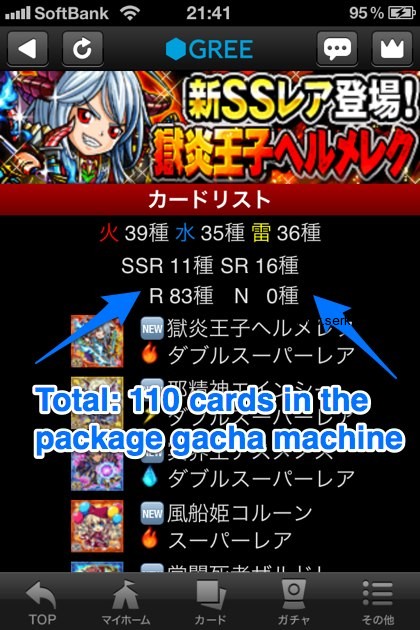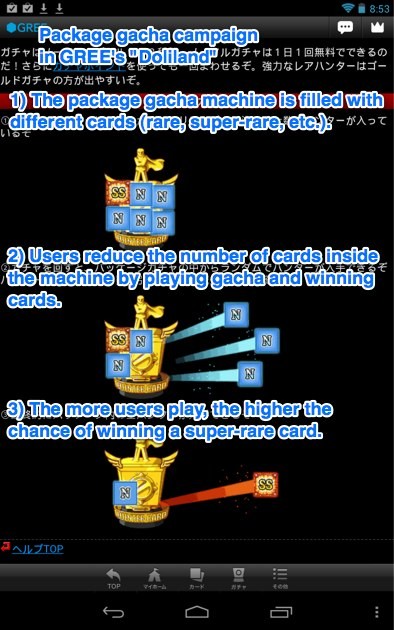It’s no exaggeration to say that the kompu gacha shock from May this year was the single biggest drawback in the history of the Japanese social gaming industry.
There is a new concept to make money in Japanese social games in town, but I think it makes sense to look back at the usage of the gacha mechanism so far first.
Gacha And Kompu Gacha So Far
As you may recall, kompu gacha (complete gacha) was a sub-form of gacha, a mystery box-like game mechanic that requires players pay money to win (or not win) virtual items – based on, well, let’s call it luck.
There is a reason for my snark: when paying for these gacha/mystery boxes, Japanese players were absolutely left in the dark about a) how many and what kind of items were actually in the gacha machine, b) at which points in time items were changed/added/removed, c) how the distribution of these items was (number of rare vs. normal items, for example), and d) how high or low the chances of winning individual items were.
Theoretically, makers could set the probability of winning items to zero at anytime they wanted without any kind of transparency, as there was absolutely no control, guideline or supervision – by anyone (the government, platform providers, industry organizations, etc.). Unbelievable, but true.
Kompu gacha was a perversion of this concept, as it required users to win a several (specified) items first in order to win a big prize (usually an item that was impossible to obtain otherwise) at the end. In other words, gacha players were required to have several “mini wins” in order to complete a set of items before getting the “jackpot”.
The items necessary to complete the set were laid out in a grid, with those that are still missing grayed out: that was essentially a bingo mechanic.
So now wonder that, following a flood of reports in local media, the Japanese government decided to crack down on kompu gacha (here is my chronology of the kompu gacha shock).
Gacha Used In Japanese Social Games Today
But gacha in its pure form, the concept of paid electronic draws to win virtual items, was left untouched – mainly because the industry was clever enough to introduce a set of self-regulatory measures to push down the element of luck and uncertainty when playing gacha.
These measures included banning several kompu gacha- and bingo-like gacha mechanisms. There was actually a whole list.
I would estimate that gacha machines can still be found in 8 out of 10 social games in Japan: the mechanic is just making too much money. I know of games where gacha contributes 50% (and more) of the entire revenue.
Spins usually cost 100 Yen, while “premium gacha machines” charge 300 Yen (but offer a higher probability of winning rare items).
Box Gacha (Package Gacha) As A Replacement For Kompu Gacha
In summer this year, right after the kompu gacha shock, Mobage operator DeNA and GREE started experimenting with new concepts, one of which seems to be especially popular right now.
DeNA calls the mechanic “box gacha” in their games, while GREE labels it as “package gacha”. It’s the same thing on both platforms and separated from normal gacha (where users pay once, spin, win – or don’t win- a valuable item, and repeat).
The box gacha concept is relatively simple: in the case of a card battle game, for example, the maker can “fill” a special gacha machine with a fixed number of rare (R), super-rare (SR), and super-special rare (SSR) cards.
The distribution is disclosed. For example, GREE ran a package gacha event a few days ago with 110 cards with different levels of rarity in the machine (SSR=11, SR=16, R=83, no “normal” cards) in their bread-and-butter game Doliland:

The difference to normal gacha is that in box gacha, users are supposed to “pull out” one card after the other out of the machine until they get the one they want. The game makers say that the cards come out randomly.
The big bullet point here is that each time a user plays gacha and wins a card, the possibility for winning one of those valuable SR/SSR cards gets higher, as the package gacha machine gets “emptier”.
In other words, box gacha is supposed to make people keep coming back to the machine and spend money until they get the card they want:
In order to boost usage in the Doliland example, there are some unusually rare cards that are only available during the period of the campaign: users can’t get certain cards anymore once the campaign is over (usually these events run over a few days).
The difference to concepts like kompu gacha, where there are documented cases in which people paid millions of yen and still didn’t get the big prize, is that box gacha gives users the chance to calculate a maximum prize for the card they want.
In the example above, one spin costs 300 yen and there are 110 cards in the box, which makes it possible for users to do the math and play with a sense of maximum damage in mind.
Note:
The text above was inspired by a recent article in Japanese news magazine FACTA.

